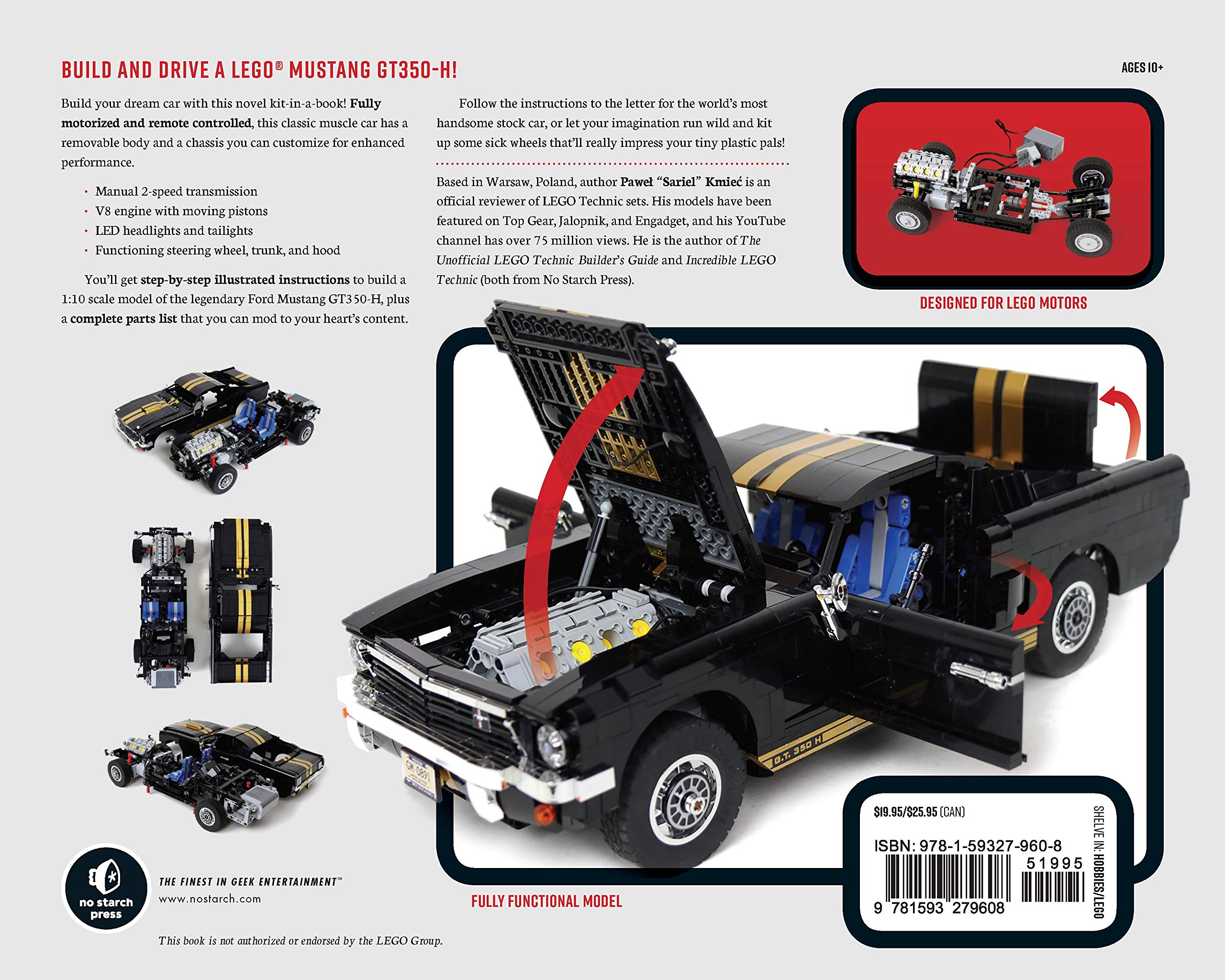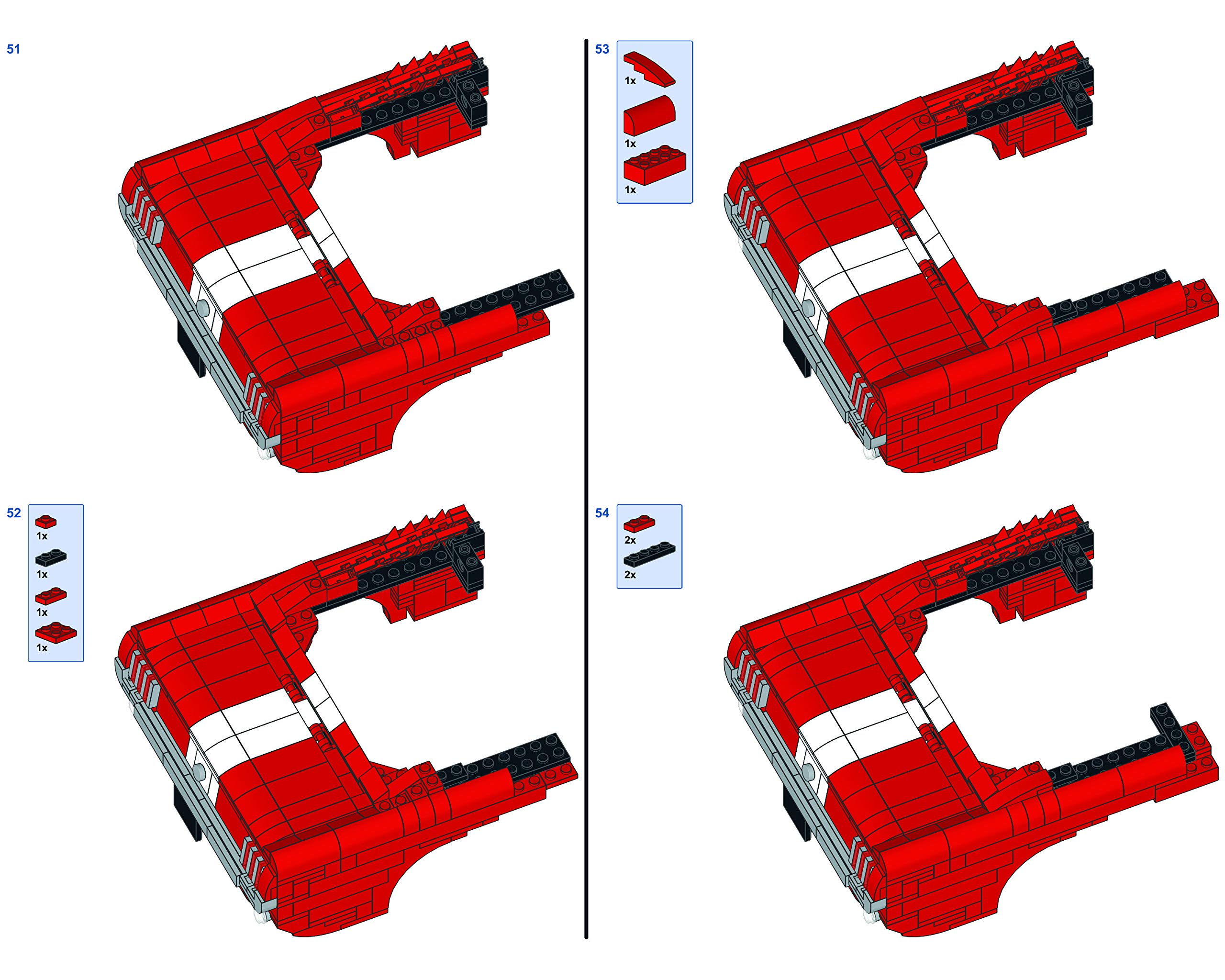I’ve been an admirer for some time of Polish LEGO fan PaweÅ‚ “Sariel†Kmieć from Warsaw, Poland. He builds some of the most brilliant LEGO scale model vehicles I’ve ever seen and is a wizard with TECHNIC mechanisms. One of his models, the Shelby GT 350-H, has been made into a book, Build a LEGO Mustang. As of this writing, Amazon offers it for US$13.99, discounted from the cover price of US$19.95. Here are the front and back covers:


If you’ve ever built a LEGO IDEAS or Architecture set, the book should seem very familiar. The first few pages talk about the author, a little history of the car, and the model itself. The GT 350-H was a souped-up 1965 Ford Mustang, modified by the Shelby company to be even more powerful, and then amazingly made available for rent by the public via Hertz Rent-A-Car! After serving for a while in Hertz’s fleet, they were returned to Ford for refurbishment and then sold to the public as the GT 350-H (the H stands for Hertz).
However, unlike an actual LEGO set, you don’t get any parts with the book; you have to supply them yourself or purchase them separately. There is a brief explanation of how to order the parts from BrickLink, and a copy of the parts list is available from No Starch’s page about the book in a format that makes that easier. One nice thing about this is you can customize the colors any way you like, so long as the parts are available. The cover shows the car in black with gold stripes and chrome trim, the instructions inside are for red with white stripes and grey trim, but you can build it in any colors you like.
Note: While LEGO has made chrome parts, they only made a few parts that way and haven’t done so in a few years. If you really want the chrome, Sariel suggests a third-party chromed part vendor, Chrome Block City on BrickLink, that will supply the needed shiny parts to bling your Mustang (or other models). Like Sariel, they are in Poland, so it may take some time to get your order. There are other vendors offering similar custom chromed parts, but I don’t have any direct experience to recommend any in particular.
You might be confused, however, if you’ve seen the new LEGO 10265 Creator Expert Ford Mustang kit. I was, at first. Judging by the photos of the finished models, there is a lot of similarity: they are both to a similar scale, and even some of the same pieces are used in a few key areas. But on closer inspection you start to see that they are totally unrelated. While I haven’t yet built Sariel’s model, I have recently built the LEGO set, and flipping through the pages of this book, it is clear to me that the designs are very different even though the finished models are about the same size and are based on the same car. If and when I actually build Sariel’s model, I’ll post a followup article here about the experience.
While this is a review about Sariel’s book, not the LEGO model, I need to talk a little about the latter for comparison. LEGO’s Mustang is quite detailed, including under the hood and trunk, and I especially admired the way the doors were hinged. It includes a mechanism to jack up the rear end, and optional instructions for making it more of a hot rod with a huge “blown” supercharger, spoilers, nitrous tank, and other enhancements. Like Sariel’s book its instruction booklet has pages of text at the start, though in Spanish and French as well as English, talking about the model and the designer, Mike Psiaki, an AFOL who was hired by LEGO and is now a Senior Model Designer. Unlike Sariel’s model, however, LEGO’s kit does not include any Power Functions options to motorize the car.
The exterior of Sariel’s Mustang is also very accurate, but the model is more focused on all the TECHNIC features Sariel is famous for–it is a completely remote-controlled car! It has motors for steering and propelling the car, a battery pack, and a Power Functions remote control receiver built in. The headlights and taillights even light up. Sariel’s car has a V-8 engine under the hood with visible moving pistons; it shows the functionality of the engine but isn’t quite as visually accurate to the actual car as LEGO’s. LEGO’s model has a nice roomy trunk, with optional nitrous oxide canister, but Sariel’s is taken over by the Power Functions. One nice advantage of Sariel’s car is that the body of the car is detachable, so you can admire all of the chassis TECHNIC details just by removing four pins and lifting off the body.
The book makes no mention of the LEGO kit, though it does say that the book was 18 months in the making, due to the challenges of coming up with building instructions for a custom model, which is something I know full well from experience can be very difficult to do, especially on a deadline. My suspicion is that both Sariel and No Starch were unaware that LEGO was working on such a kit until it was too late, and my fear is that the publication of this book so close to the release of the LEGO kit may impair sales or confuse prospective buyers. However, I would encourage anyone who loves LEGO and Mustangs to get both, because they are quite different under the hood (so to speak) and are both excellent models in their own respects.
Here are a few pages showing some of the instruction steps:



For more about Sariel check out his website sariel.pl and and the “Meet the Creator” interview on LEGO Engineering. He’s written two other books before, The Unofficial LEGO TECHNIC Builder’s Guide (1st and 2nd Editions) and Incredible LEGO TECHNIC, both also from No Starch Press. Sariel has been selected by LEGO as an official reviewer of the LEGO TECHNIC sets. Also be sure to check out his Facebook page, Flickr photos, and YouTube channel.
Disclaimer: I was sent a free review copy by the publisher. Links to Amazon on this site are affiliate links.

Sorry but they are not close in size, well not by my understanding of the word with reference to LEGO models
See Sariels video comparing the two. Sariels is approx 25% bigger